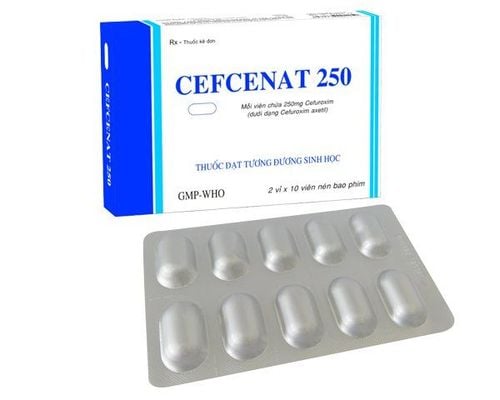This is an automatically translated article.
Kimacef - belongs to the group of anti-inflammatory and anti-parasitic drugs....The drug is sold by prescription at drugstores nationwide. Learn more about what Kimacef is used for, how to use it,... in this article.
1. What is Kimacef?
Kimacef drug is a prescription drug, prepared in powder form for injection, manufactured by pharmaceutical company JSC "Kievmedpreparat" - Ukraine. Kimacef is imported by Song Son Trading and Production Joint Stock Company, registration number VN-20684-17.
The main ingredient of Kimacef is the active ingredient Cefuroxime sodium which is equivalent to cefuiroxime and has no excipients. Packing, 1 vial / white box with dark brown bottom border, ingredients are printed in blue, drug names are printed in black. The vial has a rubber cap covered with aluminum on the neck. The powder is white or more yellow.
2. What are the effects of Kimacef?
Cefuroxime - the ingredient in Kimacef is a 2nd generation Cephalosporin bactericidal antibiotic, resistant to most beta-lactams, and active against Gram (+) and Gram (-) bacteria. . Kimacef inhibits bacterial cell wall synthesis after binding to penicillin-binding proteins. This disrupts cell wall synthesis, leading to bacterial cell lysis and death.
Kimacef drug works to kill bacteria such as:
Staphylococcus aureus, including penicillin-resistant strains (but excluding rare methicillin-resistant strains), Staph. epidermidis, Haemophilus influenzae, Klebsiella spp.,...; Salmonella typhi, S. typhimurium and Salmonella spp. other, Shigella spp., Neiseria spp. (including beta-lactamase-producing N. gonorrhoea strains), and Bordetella pertussis; Cefuroxime c6 is moderately active against Pr. vulgaris, Morganella morganii (trudc day 1a Proteus morganii) and Bacteroides fragilis; The following bacterial strains are less susceptible: Clostridium difficile, Pseudomonas spp., Campylobacter spp., Acinetobacter calcoaceticus, Legionella spp. And strains of Staph. Aureus and Staph. epidermidis resistant to methicillin; Some common strains of bacteria such as: Strep. faecalis, Morganella morganii, Proteus vulgaris, Enterobacter spp., Citrobacter spp., Serratia spp. and Bacteroides fragilis are also insensitive to Cefuroxime. In general, the drug Kimacef has a bactericidal effect when the strain is unknown or caused by susceptible bacteria. For specific diseases, it will be clearly stated in the indications section.
3. Indications to use Kimacef
Kimacef drug is indicated for infections and prevention of infections after surgery. Accordingly, Kimacef is indicated for the following cases:
Acute respiratory tract infections such as bronchitis, bronchiectasis, pneumonia, lung abscess, lung infection after surgery...; Ear - nose - throat infections: pharyngitis, sinusitis, tonsillitis,...; Urinary tract infections: acute pyelonephritis, cystitis , asymptomatic UTI; Inflammation in soft tissues: peritonitis, wound infection...; Bone and joint infections such as myelitis, arthritis, ..; Obstetric and gynecological inflammation such as pelvic inflammatory disease; Gonorrhea; Other types of infection: blood infection, meningitis...; In addition, Kimacef is also indicated for the prevention of bacterial infections in the following surgeries:
Abdominal surgery; Pelvic surgery; Blood surgery; ... In general, Kimacef is indicated for all types of bacterial infections under the guidance of doctors and pharmacists.
4. Dosage – how to use Kimacef
Dosage and way to use Kimacef drug is based on a number of factors such as: body weight and infection site, susceptibility of bacteria... Before injection, it is necessary to test the reaction on the skin to determine the severity of the infection. sensitive to the drug. Accordingly, usually Kimacef is administered by intravenous or intramuscular injection.
Intramuscular injection: Add to the vial 6ml of distilled water for injection, shake gently to form an opaque white solution for injection. Intravenous injection: mix with 15ml of distilled water for injection, if short intravenous injection, mix water with 50ml of distilled water for injection. The reconstituted solution for injection will be administered intravenously or through an infusion tube if the case is infusion. Kimacef dosage is indicated for specific diseases and subjects such as:
Gonorrhea: use a single dose or use 2 doses injected into 2 different locations; Meningitis: Kimacef alone. The recommended dosage is 1.5mg every 6 hours, not to exceed 3g every 8 hours. Children: 150-250mg/kg/day, 3-4 times a day. The dose can be adjusted to 100mg/kg/day after 3 days of treatment or clinical manifestations improve; Neonates: The first dose is 100mg/kg/day, then the dose can be adjusted down to 50mg/kg/day. Adults: 3g/ every 8 hours intravenously 3g every 8 hours. Prophylaxis: 1.5g intravenous dose in induction of anesthesia during abdominal, pelvic, orthopedic surgery can be supplemented with 2 doses of 750mg intramuscularly after 8-16 hours. For heart, lung, esophageal surgery... use 1.5g dose along with induction of anesthesia. Continue taking 750mg IM 3 times/day for 1-2 days. For cases of continuous treatment, the dose of Kimacef is as follows:
Pneumonia: dose of 1.5 g / 2 times in 48-72 hours intramuscularly or intravenously. 500mg dose divided into 2 times/day orally for 7 days; Acute and chronic bronchitis: 750 mg dose divided 2 times / day for 48-72 hours. Then take a dose of 500mg divided into 2 times/day orally for 5-7 days. Renal impairment: the drug is excreted by the kidneys, so the dose should be reduced in this group of subjects. Adults with renal failure, the dose is 750mg divided 2 times/day; ... How to use and dose Kimacef can be changed according to the doctor's prescription.
5. Contraindications to the drug Kimacef
Kimacef is not used for subjects allergic, sensitive to Cefuroxime, Ephalosporin, beta-lactam.
6. Warnings and Precautions while taking Kimacef
Caution when using Kimacef for subjects allergic to Penicillin or beta-lactams. In addition, there are some warnings and cautions as follows:
Concurrent use of high doses with Cephalosporin antibiotics with strong diuretics or Aminoglycoside antibiotics; Monitor renal function when used in subjects with renal failure and the elderly; Untimely treatment of CSF infection in patients with meningitis can lead to side effects such as deafness or neurological sequelae, ..; If the drug does not improve clinical symptoms within 72 hours, the therapy should be re-evaluated; Prescribing information regarding cefroxime should be consulted before initiating long-term therapy. In pregnant women, breast-feeding only when indicated; ... Cautions and warnings when taking Kimacef are given by the manufacturer, so it should be very careful.
7. Interaction using Kimacef
Kimacef drug is suitable for most intravenous solutions, electrolytes. However, when using it, it is also necessary to note some interactions such as:
The pH of the sodium bicarbonate injection solution 2.74% kl/tt significantly affects the color of the solution, so do not dilute it in this solution. . If necessary in case the patient is taking this solution, it can be inserted into the tube of the infusion set; Do not mix Kimacef into syringes containing Aminoglyeoside antibiotics; Concomitant use with oral contraceptives may reduce the effect; Concomitant use with anticoagulants may increase the INR. Combined with diuretics can be toxic to the kidneys; Concomitant use with antiplatelet agents may increase the risk of bleeding; ... Interactions when using Kimacef are quite complicated, so it should be used with caution when used with other drugs.
8. Side effects when using Kimacef
Using Kimacef rarely causes side effects, the effects are usually mild and transient. Some of the side effects that are warned when taking Kimacef include:
Painful reactions, thrombophlebitis at the injection site; Blood and lymphatic system disorders: Decrease in neutrophils, hemoglobin concentration; Positive Coomb's test; Hemolytic anemia; Hypersensitivity reactions, immune system disorders: rash, urticaria, pruritus, fever, subcutaneous vasculitis, anaphylaxis, Skin and subcutaneous tissue disorders: rash, urticaria, pruritus.. Renal and urinary disorders; ... It is necessary to promptly notify the doctor of all symptoms after injection for appropriate treatment.
9. Preservation of Kimacef
Store Kimacef in the new box at room temperature. The drug solution after being mixed is stored at a temperature below 4 degrees Celsius for no more than 48 hours and at 25 degrees Celsius for no more than 5 hours.
What does Kimacef do? This is an antibiotic with bactericidal effect, often used in many different types of infections as indicated. When using, it is necessary to consult a doctor to ensure safety.
Please dial HOTLINE for more information or register for an appointment HERE. Download MyVinmec app to make appointments faster and to manage your bookings easily.













